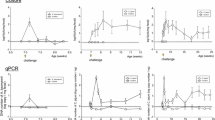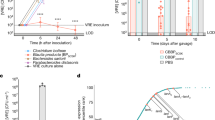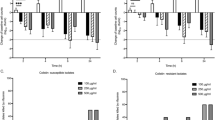Abstract
The purpose of this study was to clarify the role of the intestinal anaerobe bacteria in colonization resistance. Germfree mice were associated withEscherichia coli C25 and either (a) no other species; (b) enterococcus; (c)Escherichia coli M14 andProteus mirabilis, or (d)Bacteroides fragilis andBacteroides vulgatus. All species colonized the cecum in high numbers, but only enterococcus significantly limited the translocation ofEscherichia coli C25 to mesenteric lymph nodes. However, the overall translocation rates were similar in all groups and ranged from 60% to 100%, due to translocation of other intestinal flora in addition toEscherichia coli C25. Conventionally reared mice were given either streptomycin, bacitracin/streptomycin or metronidazole which selectively eliminated facultative gramnegative bacteria, nearly all bacterial species or strictly anaerobic bacteria respectively. Only metronidazole significantly increased the rates of translocation of normal intestinal bacteria into mesenteric lymph nodes. Cohort groups of mice were then orally inoculated with drug resistantEscherichia coli C25, which actively colonized the cecum of all drug treated mice and translocated to the mesenteric lymph nodes of approximately half the streptomycin and metronidazole treated mice and nearly all the bacitracin/streptomycin treated mice. These results indicate that anaerobic bacteria play a pivotal role in limiting the translocation of normal intestinal bacteria, but that other bacterial groups also have a role in preventing the intestinal colonization and translocation of potential pathogens.
Similar content being viewed by others
References
van der Waaij, D., Berghuis-de Vries, J.M., Lekkerkerk van der Wees, J.E.C. Colonization resistance of the digestive tract in conventional and antibiotic-treated mice. Journal of Hygiene 1971, 69: 405–411.
van der Waaij, D., Berghuis, J. M., Lekkerkerk van der Wees, J.E.C. Colonization resistance of the digestive tract of mice during systemic antibiotic treatment. Journal of Hygiene 1972, 70: 605–609.
Abrams, G.D. Effects of the normal flora on host defenses against microbial invasion. In: Mirand, E. A., Black, N. (ed): Germfree biology, Experimental and clinical aspects. Advances in experimental medicine and biology. Volume 3. Plenum Press, New York, 1969, p. 197–206.
van der Waaij, D., Berghuis-de Vries, J.M., Lekkerkerk van der Wees, J.E.C. Colonization resistance of the digestive tract and the spread of bacteria to the lymphatic organs in mice. Journal of Hygiene 1972, 70: 335–342.
Berg, R.D., Garlington, A.W. Translocation of certain indigenous bacteria from the gastrointestinal tract to the mesenteric lymph nodes and other organs in a gnotobiotic mouse model. Infection and Immunity 1979, 23: 403–404.
Steffen, E.K., Berg, R.D. Relationship between cecal population levels of indigenous bacteria and translocation to the mesenteric lymph nodes. Infection and Immunity 1983, 39: 1252–1259.
Hentges, D.J., Stein, A.J., Casey, S.W., Que, J.U. Protective role of intestinal flora against infection withPseudomonas aeruginosa in mice: influence of antibiotics on colonization resistance. Infection and Immunity 1985, 47: 118–122.
Kennedy, M.J., Volz, P.A. Ecology ofCandida albicans gut colonization: inhibition ofCandida adhesion, colonization, and dissemination from the gastrointestinal tract by bacterial antagonism. Infection and Immunity 1985, 49: 654–663.
Dekker, A. W., Rozenberg-Arska, M., Sixma, J. J., Verhoef, J. Prevention of infection by trimethoprimsulfamethoxazole plus amphotericin B in patients with acute non-lymphocytic leukemia. Annals of Internal Medicine 1981, 95: 555–559.
Guiot, H.F.L., van der Meer, J.W.M., van Furth, R. Selective antimicrobial modulation of the human microbial flora: infection prevention in patients with decreased host defense mechanisms by selective elimination of potentially pathogenic bacteria. Journal of Infectious Diseases 1981, 143: 644–654.
Hargadon, M.T., Young, V.M., Schimpff, S.C., Wade, J.C., Minah, G.E. Selective suppression of alimentary tract microbial flora as prophylaxis during granulocytopenia. Antimicrobial Agents and Chemotherapy 1981, 20: 620–621.
Wade, J.C., de Jongh, C.A., Newman, K.A., Crowley, J., Wiernik, P.H., Schimpff, S.C. Selective antimicrobial modulation as prophylaxis against infection during granulocytopenia: trimethoprim-sulfamethoxazole vs. naladixic acid. Journal of Infectious Diseases 1983, 147: 624–634.
EROTC International Antimicrobial Therapy Project Group: Trimethoprim-sulfamethoxazole in the prevention of infection in neutropenic patients. Journal of Infectious Diseases 1984, 150: 372–379.
Maejima, K., Deitch, E., Berg, R. Promotion by burn stress of the translocation of bacteria from the gastrointestinal tracts of mice. Archives of Surgery 1984, 119: 166–172.
Wells, C.L., Maddaus, M.A., Simmons, R.L. Role of the macrophage in the translocation of intestinal bacteria. Archives of Surgery 1987, 122: 48–53.
Gerhardt, P. Diluents and biomass measurement. In: Gerhardt, P. (ed.): Manual of methods for general bacteriology. American Society for Microbiology, Washington, DC, 1981, p. 504.
Finegold, S.M., Baron, E.J. Bailey and Scott's diagnostic microbiology. C.V. Mosby, St. Louis, 1986, p. 914.
Berg, R.D. Promotion of the translocation of enteric bacteria from the gastrointestinal tracts of mice by oral treatment with penicillin, clindamycin, or metronidazole. Infection and Immunity 1981, 33: 854–861.
Author information
Authors and Affiliations
Rights and permissions
About this article
Cite this article
Wells, C.L., Maddaus, M.A., Jechorek, R.P. et al. Role of intestinal anaerobic bacteria in colonization resistance. Eur. J. Clin. Microbiol. Infect. Dis. 7, 107–113 (1988). https://doi.org/10.1007/BF01962194
Issue Date:
DOI: https://doi.org/10.1007/BF01962194




